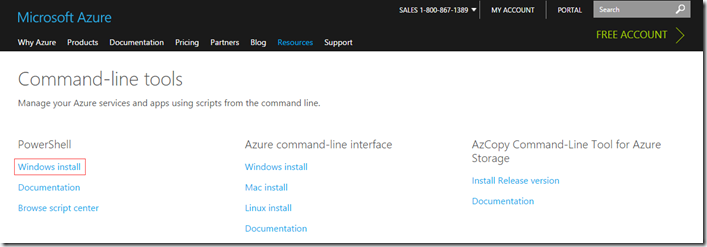使用 PowerShell 自動化 CloudServices 釋出
在軟體的開發過程中,自動化的編譯和部署能夠帶來很多的優勢。如果可以透過一個指令碼實現軟體的自動化部署,那麼就可以節省大量的時間去做其它事情。
下面介紹如何將雲應用程式透過 PowerShell 自動釋出到 azure 的 cloud services 上。
一、打包需要釋出的內容
首先使用 msbuild 編譯 *.ccproj 檔案,在生成的所有檔案中,我們需要用到以下兩個:
app.publish\xxx.cspkg
app.publish\yyy.cscfg
二、下載 publishsettings 檔案
有以下兩種方法可以下載 publishsettings 檔案:
1、如果沒有 Azure 賬號,則需要先註冊賬號;如果已有 Azure 賬號,可直接登入下面的地址,下載 publishsettings 檔案(國際版):
下載到的檔案的檔名:
xxx5-18-2016-credentials.publishsettings
其中xxx是你的 subscription 名稱。
2、在 powershell 中執行 Get-AzurePublishSettingsFile 命令,實現下載 publishsettings 檔案的目的。
三、安裝 powershell 的 azure module
訪問 網址, 點選 “Command-line tools->PowerShell” 下面的 “Windows install” 下載安裝包。
執行安裝包,安裝 azure modules。
四、建立自動釋出的指令碼
1、匯入 azure module
在 powershell 中執行命令 Import-Module Azure,匯入 azure module
2、設定指令碼中使用的變數,其中部分引數變數需要根據自己的資訊設定
$package = app.publish\xxx.cspkg
$configuration = app.publish\yyy.cscfg
# subscription 名稱
$subscription = "your subscription name";
# service 名稱
$service = "your service name";
# storage account
$storage = "your storage account";
# slot 名稱,一般會先發到 staging 中,檢查後再進行切換
$slot = "Staging";
# 為每次釋出提供一個說明資訊
$deploymentLabel = “your demplyment label”
3、匯入 publish settings
因為 publish settings 檔案中記錄了 subscription 資訊以及用於登入的驗證資訊,所以需要先把這些資訊匯入進來。
執行命令:Import-AzurePublishSettingsFile publishsettings-file-path
需要注意的是:
在匯入前需要先檢查一下,檢視這個檔案對應的 subscription 是否已被匯入,可以透過以下命令進行驗證。
$thisSubscriptionExist = $False
$subs = Get-AzureSubscription
if ($subs.Count - gt 0)
{
Foreach($sub in $subs)
{
if ($sub.SubscriptionName - eq $subscription)
{
$thisSubscriptionExist = $True
}
}
}
如果不存在,則需要執行匯入操作;如果存在,則直接進行下一步。
if (!$thisSubscriptionExist)
{
Import - AzurePublishSettingsFile $subscriptionSetting
// 為subscription 新增一個storage account
Set - AzureSubscription - CurrentStorageAccount $storage - SubscriptionName $subscription
}
4、設定當前的 subscription
從上一步中可以發現,機器上可能同時儲存了多個 subscription 的資訊。那麼,當執行釋出操作時,預設會使用哪個 subscription 的資訊呢?這裡存在“當前 subscription”的概念,釋出操作會使用當前 subscription 的資訊進行釋出。因此,在釋出操作之前一定要設定本次釋出使用的 subscription 為當前 subscription。
執行 Select-AzureSubscription -SubscriptionName $subscription –Current 命令進行設定
5、檢查 deployment 是否存在
在執行部署前需要先檢查 deployment 是否存在,這會影響到後面的部署方式。如果 deployment 不存在,則需要先建立 deployment。如果 deployment 已經存在,則需要更新 deployment。
命令邏輯如下:
$deployment = Get-AzureDeployment -ServiceName $service -Slot $slot -ErrorVariable a -ErrorAction silentlycontinue
if ($deployment.Name -ne $null)
{
# deployment 已經存在,使用 Set-AzureDeployment 命令進行更新,第7步會詳細說明
}
else
{
# 需要使用 New-AzureDeployment 命令新建 deployment,第6步會詳細說明
}
6、新建 deployment 並檢查部署是否成功的命令
New-AzureDeployment -Slot $slot -Package $package -Configuration $configuration -label $deploymentLabel -ServiceName $service;
$completeDeployment = Get-AzureDeployment -ServiceName $service -Slot $slot;
//檢查部署是否成功
$completeDeploymentID = $completeDeployment.deploymentid;
7、更新已經存在的部署並檢查部署是否成功的命令
Set-AzureDeployment -Upgrade -Slot $slot -Package $package -Configuration $configuration -label $deploymentLabel -ServiceName $service -Force;
$completeDeployment = Get-AzureDeployment -ServiceName $service -Slot $slot;
//檢查部署是否成功
$completeDeploymentID = $completeDeployment.deploymentid;
8、從網站上檢視釋出結果
釋出完成後,可以從網站上檢視釋出結果。
其中,Deployment label 是在釋出指令碼中設定的,一般會寫入釋出日期和版本號;Deployment ID 是標識本次部署的 GUID。
總結,PowerShell 的 azure 模組已經提供了很完善的命令供我們進行自動化的釋出使用,我們只需要將這些命令組織成指令碼就可以了。
來自 “ ITPUB部落格 ” ,連結:http://blog.itpub.net/28298702/viewspace-2120591/,如需轉載,請註明出處,否則將追究法律責任。
相關文章
- Azure 基礎:用 PowerShell 自動釋出 CloudServicesCloud
- Unit42釋出powershell自動反混淆工具
- 使用 Github Action 進行前端自動化釋出Github前端
- 使用PowerShell/CMD自動化安裝並配置MySQL資料庫MySql資料庫
- 前端自動化釋出實戰總結前端
- ReactNative專案自動化打包釋出React
- [譯] 使用 Travis CI 自動釋出 npmNPM
- React Native專案自動化打包釋出React Native
- 前端自動化:Node 命令列前端自動構建釋出系統前端命令列
- 使用Jenkins實現前端自動化釋出和通知,讓你的釋出只需要git pushJenkins前端Git
- Jenkins 構建自動化 .NET Core 釋出映象Jenkins
- 基於DotNetty實現自動釋出 - 自動檢測程式碼變化Netty
- iOS自動整合打包釋出iOS
- 一鍵實現自動化部署(灰度釋出)實踐
- asp.net core + jenkins 實現自動化釋出ASP.NETJenkins
- Git + Jenkins 自動化 NGINX 釋出簡易實現GitJenkinsNginx
- [學習筆記]使用Docker+Jenkin自動化流水線釋出.Net應用筆記Docker
- 【VMware vSphere】使用RVTools中的PowerShell指令碼建立匯出vSphere環境資訊的自動化任務。指令碼
- 開機自啟動Powershell指令碼指令碼
- netcore使用 jenkins + supervisor 實現standalone下多副本自動化釋出NetCoreJenkins
- [Gitlab]使用Webhook實現前端專案自動釋出GitlabWebHook前端
- iOS 自動化釋出 Fastlane 本地構建 IPA 並分發iOSAST
- 利用 GitHub Action 自動釋出 DockerGithubDocker
- Azure 基礎:用 PowerShell 自動登入
- Jenkins+Fastlane+自動化打包釋出+蒲公英二維碼展示JenkinsAST
- 阿里雲釋出ECS自動化運維套件,幫助企業實現自動化運維轉型阿里運維套件
- jenkins自動釋出java程式碼JenkinsJava
- CODING DevOps + Nginx-ingress 實現自動化灰度釋出devNginx
- Bitbucket Pipes釋出,帶來30+自動化CI/CD管道的方法
- 使用 Gitlab CI/CD 實現自動化釋出站點到 IISGitlab
- 用GitHub Actions自動釋出Hexo部落格GithubHexo
- appuploader iOS 應用自動釋出APPiOS
- iOS自動構建打包釋出指令碼iOS指令碼
- 二、web自動化快速使用Web
- iOS自動化打包(fastlane使用)iOSAST
- PowerShell使用
- PowerShell 使用
- Linkerd 2.10(Step by Step)—2. 自動化的金絲雀釋出

